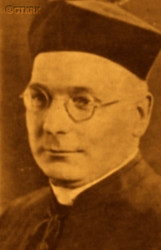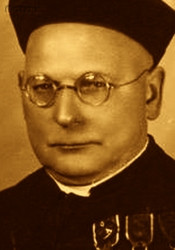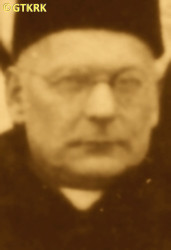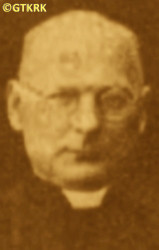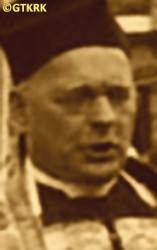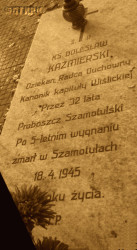Roman Catholic
St Sigismund parish
05-507 Słomczyn
85 Wiślana Str.
Konstancin deanery
Warsaw archdiocese, Poland
full list:
displayClick to display full list

searchClick to search full list by categories
wyświetlKliknij by wyświetlić pełną listę po polsku

szukajKliknij by przeszukać listę wg kategorii po polsku

Martyrology of the clergy — Poland
XX century (1914 – 1989)
personal data
surname
KAŹMIERSKI
forename(s)
Boleslav (pl. Bolesław)
function
diocesan priest
creed
Latin (Roman Catholic) Church RCmore on
en.wikipedia.org
[access: 2014.09.21]
diocese / province
Gniezno and Poznań archdiocese (aeque principaliter)more on
www.archpoznan.pl
[access: 2012.11.23]
RC Military Ordinariate of Polandmore on
en.wikipedia.org
[access: 2014.12.20]
honorary titles
canonmore on
en.wikipedia.org
[access: 2014.11.14]
(till 1945, Nativity of the Blessed Virgin Mary RC collegiate church, Wiślicatoday: Wiślica gm., Busko‐Zdrój pov., Holy Cross voiv., Poland
more on
en.wikipedia.org
[access: 2021.06.07])
Prelate‐provost (Lat. praelati‐praepositus)more on
en.wikipedia.org
[access: 2015.03.01]
(till 1935, Our Lady of Consolation and St Stanislav the Bishop and Martyr RC collegiate church, Szamotułytoday: Szamotuły gm., Szamotuły pov., Greater Poland voiv., Poland
more on
en.wikipedia.org
[access: 2021.06.20])
Ad Honores Spiritual Counselor
(c. 1925)
„Medal of Independence”more on
en.wikipedia.org
[access: 2019.02.02]
(16.03.1933)
„Polonia Restituta” Cross — 4th Class, Officer'smore on
en.wikipedia.org
[access: 2019.04.16]
(27.11.1929)
Gold „Cross of Merit”more on
en.wikipedia.org
[access: 2019.04.16]
(22.12.1928)
Medal „Poland To Its Defender”
„Gen. Haller's Sword” badgemore on
pl.wikipedia.org
[access: 2025.08.19]
„For Valor” Crossmore on
pl.wikipedia.org
[access: 2025.08.19]
date and place
of death
14.04.1945

Szamotułytoday: Szamotuły gm., Szamotuły pov., Greater Poland voiv., Poland
more on
en.wikipedia.org
[access: 2021.06.20]
details of death
On c. 10.11.1918, day after the abdication on 09.11.1918 of the German Emperor William II Hohenzollern, a Soldiers' Council and a Workers' Council were established in Szamotuły — following the example of those established in revolted Berlin — but consisting mostly of Poles.
A day later, on 11.11.1918, World War I ended — on that day, in a staff wagon in Compiègne, at the headquarters of French Marshal Ferdinand Foch, an armistice between the Allies and the Germans was signed. On the same day, the Regency Council established by the Central Powers (Germany and Austro–Hungary) and operating in the so‐called Germ. Königreich Polen (Eng. Kingdom of Poland), transferred supreme authority over the army to Brigadier Joseph Piłsudski and appointed him Commander‐in‐Chief of the Polish Army, which de facto meant the rebirth of the Polish state. And on the same day, in Poznań, the Polish clandestine Inter‐Party Committee finally revealed itself — since 1917 it had been in contact, and therefore de facto committing an act of treason against the German state, with the Polish National Committee in Paris, the capital of the state fighting against the Germans, which it recognized as the legal authorities of Poland — with which it had been in secret contact since 1918, and formed the Polish People's Council, renamed three days later to the Supreme People's Council, which openly supported the idea of creating a united Polish state. On its call on c. 15‐16.11.1918, the County People's Council was established in Szamotuły, seat of Germ. Kreis Samter (Eng. Szamotuły County), part of Prussian Germ. Provinz Posen (Eng. Poznań Province), of which became a chairman of.
Both Councils operated — thanks to the Polish majority — in principle in harmony, step by step taking over the reins of government in the city (apart from the German army and police). Participated in organizing Polish education, led an awareness campaign among Poles. Organized also the material foundations of the Polish armed forces being formed in the town – including a sewing factory, which made uniforms for Polish volunteers.
On 26.12.1918, was at the Poznań train station, welcoming, together with a delegation from Szamotuły, led by him, the outstanding pianist Ignatius John Paderewski, who was returning to Poland. The huge welcome and escort to the hotel thwarted the plans of the Germans, who intended to intercept the musician, not to let him into the city, but to send him to Warsaw (an order for immediate leave of the city was even issued, but the Germans failed to deliver it). The next day, the Germans caused riots in the city and the Greater Poland Uprising of 1918‐1919 began.
During the Uprising, publicly encouraged Poles to donate gifts and funds — gold, silver, etc. — to the insurgents. Made the premises of the rectory available to the staff of local front‐line insurgent units, becoming their chaplain. The Uprising ended on 16.02.1919 with the armistice in Trier, enforced by the victorious Entente states, under which the Polish insurgent Greater Poland Army was recognized as an allied army and a border was set, which „German troops were forbidden to cross”, leaving a large part of Greater Poland outside their influence. On 28.06.1919, a peace treaty with Germany was signed in Versailles and Greater Poland, including the Szamotuły county, was awarded to Poland, although the precise border line was to be determined by the international Delimitation Commission. The treaty entered into force on 10.01.1920, after the necessary ratifications, and Szamotuły became part of Poland.
After the German invasion of Poland on 01.09.1939 (the Russians attacked Poland 17 days later) and the beginning of World War II, the civilian authorities of Szamotuły abandoned the town on the first day of the war (Szamotuły was located c. 40 km from the Polish–German border). On 02.09.1939 spoke in the market square: „The enemy is approaching. Let us not give in to despair! Let the men flee, let them try to get into the army. Let the women and children stay. And I, your pastor, will stay with you and my vicars will also remain. Let us trust in God and the Most Holy Mary, the Lady of Szamotuły”. On 04.09.1939, in the absence of authorities, organized the Citizens' Committee, becoming its head.
The Germans entered Szamotuły on 07.09.1939 early in the morning. The first act was to arrest him and his vicars. They were all taken to the town hall and locked up — along with several Szamotuły Jews — in a coal cellar. They were released in the afternoon, but for several days were kept under house arrest, treated as hostages, in case of Polish resistance.
Evicted by the Germans from the rectory. Moved to the St.
Joseph's Institute, a hospital run by the Franciscan Sisters of the Family of Mary CSFFM, and in 11.1939 to a room at one of the parishioners' houses.
Arrested by the Germans on 14.03.1940.
Held in the transit camp for Catholic priests IL Chludowo.
Avoided deportation to concentration camps (on 22.05.1940 most of the priests were deported from IL Chludowo and finally transported to the KL Dachau camp). According to some sources, prob. transferred to another transit camp for Catholic priests, IL Lubin, from where on 06.10.1941 some of the priests were transported to KL Dachau.
Deported to the east, to the German‐run Germ. Generalgouvernement (Eng. General Governorate).
Settled in Kielce.
Perished immediately after returning on c. 01.04.1945 to the Szamotuły parish — after the defeat of Germany and the beginning of another Russian occupation (Russians entered Szamotuły on 26.01.1945).
cause of death
exhaustion
perpetrators
Germans
sites and events
GeneralgouvernementClick to display the description, Deportations from Reichsgau WarthelandClick to display the description, 06.10.1941 arrests (Warthegau)Click to display the description, IL LubinClick to display the description, IL ChludowoClick to display the description, 02‐03.1940 arrests (Warthegau)Click to display the description, Reichsgau WarthelandClick to display the description, «Intelligenzaktion»Click to display the description, Collective responsibility („Hostages”)Click to display the description, Ribbentrop‐MolotovClick to display the description, Pius XI's encyclicalsClick to display the description, Greater Poland UprisingClick to display the description
date and place
of birth
15.05.1879Birth certification on:
photos.szukajwarchiwach.gov.pl
[access: 2025.08.19]

Żegocintoday: Czermin gm., Pleszew pov., Greater Poland voiv., Poland
more on
en.wikipedia.org
[access: 2021.04.01]
parents
KAŹMIERSKI Theophilus
🞲 ?, ? — 🕆 ?, ?

WYSZYŃSKA Rosalie
🞲 ?, ? — 🕆 ?, ?
presbyter (holy orders)
ordination
01.12.1902

Gnieznotoday: Gniezno urban gm., Gniezno pov., Greater Poland voiv., Poland
more on
en.wikipedia.org
[access: 2021.12.18]
Assumption of the Blessed Virgin Mary RC archcathedral churchmore on
en.wikipedia.org
[access: 2025.03.14]
positions held
1945
parish priest — Szamotułytoday: Szamotuły gm., Szamotuły pov., Greater Poland voiv., Poland
more on
en.wikipedia.org
[access: 2021.06.20] ⋄ St Stanislav the Bishop and Martyr RC parish ⋄ Szamotułytoday: Szamotuły gm., Szamotuły pov., Greater Poland voiv., Poland
more on
en.wikipedia.org
[access: 2021.06.20] RC deanery
c. 1941 – 1945
resident — Kielcetoday: Kielce city pov., Holy Cross voiv., Poland
more on
en.wikipedia.org
[access: 2021.06.07] ⋄ Assumption of the Blessed Virgin Mary RC cathedral church — after deportation from a new occupational German Germ. Reichsgau Wartheland (Eng. Wartheland Reichs' Region) province, formed in Greater Poland; also: notary of the Diocesan Curia of the Kielce diocese
1930 – 1940
dean — Szamotułytoday: Szamotuły gm., Szamotuły pov., Greater Poland voiv., Poland
more on
en.wikipedia.org
[access: 2021.06.20] RC deanery
1913 – 1940
parish priest — Szamotułytoday: Szamotuły gm., Szamotuły pov., Greater Poland voiv., Poland
more on
en.wikipedia.org
[access: 2021.06.20] ⋄ St Stanislav the Bishop and Martyr RC parish ⋄ Szamotułytoday: Szamotuły gm., Szamotuły pov., Greater Poland voiv., Poland
more on
en.wikipedia.org
[access: 2021.06.20] RC deanery — also: member of the Parish Priests‐Consultors Council in the Poznań Archdiocesan Curia (c. 1929‐1940), member of the Administrative Council of the Poznań Archdiocesan Curia (c. 1936‐1940), county inspector of religion classes in elementary schools (c. 1938‐1940), spiritual counselor (c. 1926‐ 1936), President of the Council of the „Young Polish Women” Association(c. 1930‐1934), decanal notary (c. 1923‐1930), counselor of the Administrative Court of the Poznań Archdiocesan Curia (c. 1925‐1927), president of the Women's Associations of both archdioceses (c. 1924‐1927); activist, district treasurer (from 1914), member of the board (from 1937) of the Karol Marcinkowski Scientific Aid Society; president of the district branch of the People's Reading Rooms Society (from 1913); president of the Supervisory Board of the People's Bank (from 1913)
till c. 1935
Prelate‐provost (Lat. praelati‐praepositus) — Szamotułytoday: Szamotuły gm., Szamotuły pov., Greater Poland voiv., Poland
more on
en.wikipedia.org
[access: 2021.06.20] ⋄ Collegiate Chapter ⋄ St Stanislav the Bishop and Martyr RC collegiate church — titular — in practice the collegiate chapter did not exist and was formally dissolved c. 1935
1925 – 1929
membership — Szamotułytoday: Szamotuły gm., Szamotuły pov., Greater Poland voiv., Poland
more on
en.wikipedia.org
[access: 2021.06.20] ⋄ County Assembly–Sejmik
1923 – 1928
membership — Szamotułytoday: Szamotuły gm., Szamotuły pov., Greater Poland voiv., Poland
more on
en.wikipedia.org
[access: 2021.06.20] ⋄ City Council
1905 – 1913
director — Poznańtoday: Poznań city pov., Greater Poland voiv., Poland
more on
en.wikipedia.org
[access: 2021.07.18] ⋄ Office, Archbishop's Ordinariate Council
1905 – 1913
vicar — PoznańOstrów Tumski
today: Poznań city pov., Greater Poland voiv., Poland
more on
en.wikipedia.org
[access: 2022.02.03] ⋄ St Peter and St Paul the Apostles RC archcathedral church — also: from c. 1907 deputy dean of the cathedral chapter (the dean at that time was the suffragan of Gniezno and Poznań, Bp Eduard Likowski)
1906
chaplain — Dresdentoday: Saxony state, Germany
more on
en.wikipedia.org
[access: 2022.08.05] ⋄ Germ. Residenzschloß (Eng. Residential castle), monarch of Saxony — Saxony was part of the German Empire, and the monarch was Frederick Augustus III of Saxony; also: chaplain among Polish emigrants and migrants
1902 – 1904
vicar — PoznańJeżyce neighborhood
today: Poznań city pov., Greater Poland voiv., Poland
more on
en.wikipedia.org
[access: 2021.07.18] ⋄ Sacred Heart of Jesus and St Florian RC parish ⋄ Poznańtoday: Poznań city pov., Greater Poland voiv., Poland
more on
en.wikipedia.org
[access: 2021.07.18] RC deanery
till 1902
student — Gnieznotoday: Gniezno urban gm., Gniezno pov., Greater Poland voiv., Poland
more on
en.wikipedia.org
[access: 2021.12.18] ⋄ philosophy and theology, Archbishop's Practical Theological Seminary (Lat. Seminarium Clericorum Practicum)
from 1899
student — Poznańtoday: Poznań city pov., Greater Poland voiv., Poland
more on
en.wikipedia.org
[access: 2021.07.18] ⋄ philosophy and theology, Archbishop's Theological Seminary (Collegium Leoninum)
membership — Poznańtoday: Poznań city pov., Greater Poland voiv., Poland
more on
en.wikipedia.org
[access: 2021.07.18] ⋄ Friends of Sciences Society
others related
in death
ADAMSKIClick to display biography Ignatius, BINEKClick to display biography Silvester, DĄBROWSKIClick to display biography Steven, DUDZIŃSKIClick to display biography Stanislav, GIEBUROWSKIClick to display biography Vaclav Casimir, GRASZYŃSKIClick to display biography Alphonse, HAŁASClick to display biography Anthony, HEYDUCKIClick to display biography Ceslav, KRUSZKAClick to display biography Steven, MICHALSKIClick to display biography Stanislav, PANEWICZClick to display biography Roman, PANKOWSKIClick to display biography Peter Romualdo Casimir, ROSENBERGClick to display biography Louis, SOŁTYSIŃSKIClick to display biography Romualdo, ŚPIKOWSKIClick to display biography Marian, TACZAKClick to display biography Theodore, THEINERTClick to display biography Roman Sigismund, WIERZCHACZEWSKIClick to display biography Maximilian Francis Ambrose, WOLSKIClick to display biography Francis, ZWOLSKIClick to display biography Steven, BAJEROWICZClick to display biography Adalbert Stanislav, KANIEWSKIClick to display biography Zbigniew, NIKLEWICZClick to display biography Ceslav Vladislav, PACEWICZClick to display biography Vaclav, STEINMETZClick to display biography Paul, ZALEWSKIClick to display biography Edward Victor, GRAETZClick to display biography Ceslav John Michael, POPRAWSKIClick to display biography Marian, WINGERClick to display biography Leo
sites and events
descriptions
Generalgouvernement: After the Polish defeat in the 09.1939 campaign, which was the result of the Ribbentrop‐Molotov Pact and constituted the first stage of World War II, and the beginning of German occupation in part of Poland (in the other, eastern part of Poland, the Russian occupation began), the Germans divided the occupied Polish territory into five main regions. In two of them new German provinces were created, two other were incorporated into other provinces. However, the fifth part was treated separately, and in a political sense it was supposed to recreate the German idea from 1915 (during World War I, after the defeat of the Russians in the Battle of Gorlice in 05.1915) of creating a Polish enclave within Germany. Illegal in the sense of international law, i.e. Hague Convention, and public law, managed by the Germans according to separate laws — especially established for the Polish Germ. Untermenschen (Eng. subhumans) — till the Russian offensive in 1945 it constituted part of the Germ. Großdeutschland (Eng. Greater Germany). Till 31.07.1940 formally called Germ. Generalgouvernement für die besetzten polnischen Gebiete (Eng. General Government for the occupied Polish lands) — later simply Germ. Generalgouvernement (Eng. General Governorate), as in the years 1915‐1918. From 07.1941, i.e. after the German attack on 22.06.1941 against the erstwhile ally, the Russians, it also included the Galicia district, i.e. the Polish pre‐war south‐eastern voivodeships. A special criminal law was enacted and applied to Poles and Jews, allowing for the arbitrary administration of the death penalty regardless of the age of the „perpetrator”, and sanctioning the use of collective responsibility. After the end of the military conflict of the World War UU, the government of the Germ. Generalgouvernement was recognized as a criminal organization, and its leader, governor Hans Frank, guilty of war crimes and crimes against humanity and executed. (more on: en.wikipedia.orgClick to attempt to display webpage
[access: 2024.12.13])
Deportations from Reichsgau Wartheland: After defeating Poland in 1939 a new province was created in Germany, Germ. Reichsgau Wartheland (Eng. Warta German Region) and defined as „indigenous German”, although in 1939 Germans constituted less than 10% of the total population there. In the same 1939, the national‐socialist leader of Germany, Adolf Hitler, announced the need to move Germans from the East to the Reich, mainly to the Germ. Reichsgau Wartheland. Another German leader, Robert Ley, stated, „In 50 years there will be a thriving German country where there will be neither a Pole nor a Jew! If someone asks me where they will be, I will answer: I don't know. In Palestine or in the Sahara desert, I don't care. But German people will live here!” Deportations began. By the end of 1939, c. 80 railway transports were sent to the Germ. Generalgouvernement (Eng. General Governorate) — a total of 87,883 people, mainly Poles and Jews. By 03.1941, over 280,000 people had been displaced. The deported had the right to take with them 12‐30 kg per person. They were given half an hour to pack. Over 60,000 Germans from Estonia, Latvia, Finland, later from other regions, were brought in to replace them. In 1941, c. 70,000 remaining Jewsa were displaced. (more on: pl.wikipedia.orgClick to attempt to display webpage
[access: 2022.11.20])
06.10.1941 arrests (Warthegau): On 13.09.1941 Germ. Gauleiter (Eng. regional leader) of German province Germ. Reichsgau Wartheland (Eng. Wartheland Reich district), in German‐occupied Greater Poland (where German standard law was in force), Artur Greiser, implementing „Ohne Gott, ohne Religion, ohne Priesters und Sakramenten” — „without God, without religion, without priest and sacrament” — policy issued a decree formally dissolving Catholic Church and forming in its place a Roman Catholic German National Church in Germ. Warthegau, an organization subject to a German private law. The ordinance was issued backdated to 01.09.1939, i.e. the date of the German invasion of Poland, which sanctioned the later robbery of the property of the Catholic Church acting for the benefit of the Polish population by the Germans. All the contacts with Vatican were forbidden. All the religion congregations were also dissolved. Soon after, on 06‐07.10.1941, mass arrests of Polish Catholic priests took place — c. 352 were detained. All were herded into DL Konstantinow in Konstantynów or IL Lond in Ląd on Warta river transit camps or KL Posen concentration camp (in this case, the detainees were first registered, photographed and examined in the infamous Poznań headquarters of the German political police, the Gestapo, in the former Soldier's House). On 30.10.1941 most of them were transported to KL Dachau concentration camp.
IL Lubin: The Gestapo District Office in Poznań issued on 13.12.1939 executive instruction Ref. IIB No. 406/39 Tgb. No. 3045/39, ordering: „Based on the regulation of the Germ. Höherer SS‐ und Polizeiführer (Eng. Higher Commander of the SS and Police) [of the Germ. Warthegau (Eng. Greater Poland)] province of 12.11.1939 [SS‐Gruppenführer Wilhelm Koppe], apart from Poles and Jews, also Catholic clergy will be expelled. Action against this group of people should be carried out in such a way that internment and transport are separate […] C. 80% of Catholic clergy are expected to be expelled. The selection based on political threat posed. Internees cannot be placed in regular transit camps due to the possibility of international protest. Catholic clergy should be interned in men's monasteries and held there till mass transportation out”. And so at the Benedictine abbey in Lubiń near Kościan, at the beginning of 1940, the Germans — Germ. Geheime Staatspolizei (Eng. Secret State Police), i.e. Gestapo — organized an temporary Germ. „Internierungslager” (Eng. „Internment camp”) IL Lubin for priests and friars from Greater Poland (dated from 15.02.1940, although the Germans brought several priests to the abbey earlier). E.g. in 04.1941 Franciscan friars from Goruszki monastery were brought in. In total, 104 clergymen were held in the monastery. On 06.10.1941, as part of the third great operation of arrests of the Polish clergy of Greater Poland — more precisely, from the Germ. Warthegau occupational province — all interned priests were transported to the KL Dachau concentration camp. Religious brothers were allowed to return to their family homes. The monastery was turned into an old people's home, and later as a training center for national‐socialist German youth, Germ. „Hitler‐Jugend” (Eng. „Hitler youth”). Rich library collections and other goods were plundered. The Benedictines returned to the monastery on 25.01.1945, after the German defeat. (more on: www.benedyktyni.netClick to attempt to display webpage
[access: 2013.08.10], pl.wikipedia.orgClick to attempt to display webpage
[access: 2013.08.10])
IL Chludowo: The Gestapo District Office in Poznań issued on 13.12.1939 executive instruction Ref. IIB No. 406/39 Tgb. No. 3045/39, ordering: „Based on the regulation of the Germ. Höherer SS‐ und Polizeiführer (Eng. Higher Commander of the SS and Police) [of the German province of Warthegau (Eng. Greater Poland)] of 12.11.1939 [SS‐Gruppenführer Wilhelm Koppe], apart from Poles and Jews, also Catholic clergy will be expelled. Action against this group of people should be carried out in such a way that internment and transport are separate […] C. 80% of Catholic clergy are expected to be expelled. The selection based on political threat posed. Internees cannot be placed in regular transit camps due to the possibility of international protest. Catholic clergy should be interned in men's monasteries and held there till mass transportation out”. One of them was the house of the Divine Word Missionaries SVD in Chludowo, c. 20 km north of Poznań, purchased by the Congregation in 1934 from one of the most outstanding Polish politicians and publicists, Roman Dmowski. The Germans — Germ. Geheime Staatspolizei (Eng. Secret State Police), i.e. Gestapo — on 25.01.1940 established there the Germ. „Internierungslager” (Eng. „internment camp”) IL Chludowo for the Catholic clergy. All the friars present were interned, effectively deprived of means of subsistence, and over 60 arrested priests from nearby parishes of the Poznań and Gniezno archdioceses were transported in. On 22.05.1940, most of them were deported — through the KL Posen concentration camp — to the KL Dachau concentration camp in Bavaria. The facility was then handed over to the German Wehrmacht army, its XXI Wehrkreis (Eng. Military District), covering Greater Poland occupied by the Germans, and prob. was still used as a IL XXI Chludowo POW camp for Poles. In 1943, the camp was liquidated and the Germans established an observation point for the German Luftwaffe Air Force in the buildings. (more on: pl.wikipedia.orgClick to attempt to display webpage
[access: 2012.11.23])
02‐03.1940 arrests (Warthegau): First large wave of arrests of Polish Catholic clergy from German occupied Greater Poland region, transformed in to German province Germ. Reichsgau Wartheland (Eng. Greater Poland Reichs District), started in fact in 01.1940 but the largest numbers of priest were captured in 02‐03.1940. In accordance with a plan of „Ohne Gott, ohne Religion, ohne Priesters und Sakramenten” — „without God, without religion, without priest and sacrament” — being implemented by the Germ. Gauleiter (Eng. regional leader) of Germ. Reichsgau Wartheland, Artur Greiser, few hundred of Polish priests were interned in transit camps in Puszczykowo, IL Lubin in Lubiń, IL Bruckau in Bruczków, IL Görchen in Goruszki, IL Chludowo in Chludowo and KL Posen (Fort VII) concentration camp in Poznań, prior to transfer to concentration camps deep within Germany.
Reichsgau Wartheland: After the Polish defeat in the 09.1939 campaign, which was the result of the Ribbentrop‐Molotov Pact and constituted the first stage of World War II, and the beginning of German occupation in part of Poland (in the other, eastern part of Poland, the Russian occupation began), the Germans divided the occupied Polish territory into five main regions (and a few smaller). The largest one was transformed into Germ. Generalgouvernement (Eng. General Governorate), intended exclusively for Poles and Jews and constituting part of the so‐called Germ. Großdeutschland (Eng. Greater Germany). Two were added to existing German provinces. From two other separate new provinces were created. Greater Poland region was one of them, incorporated into Germany on 08.10.1939, by decree of the German leader Adolf Hitler (formally came into force on 26.10.1939), and on 24.01.1940 transformed into the Germ. Reichsgau Wartheland (Eng. Wartheland Reich Province), in which the law of the German state was to apply. The main axis of the policy of the new province, the territory of which the Germans recognized as the Germ. „Ursprünglich Deutsche” (Eng. „natively German”), despite the fact that 90% of its inhabitants were Poles, was Germ. „Entpolonisierung” (Eng. „Depolonisation”), i.e. forced Germanization. C. 100,000 Poles were murdered as part of the Germ. „Intelligenzaktion”, i.e. extermination of Polish intelligentsia and ruling classes. C. 630,000 were forcibly resettled to the Germ. Generalgouvernement, and their place taken by the Germans brought from other areas occupied by Germany (e.g. the Baltic countries, Bessarabia, Bukovina, etc.). Poles were forced to sign the German nationality list, the Germ. Deutsche Volksliste DVL. As part of the policy of „Ohne Gott, ohne Religion, ohne Priesters und Sakramenten” (Eng. „No God, no religion, no priest or sacrament”) most Catholic priests were arrested and sent to concentration camps. All schools teaching in Polish, Polish libraries, theaters and museums were closed. Polish landed estates confiscated. To further reduce the number of the Polish population, Poles were sent to forced labor deep inside Germany, and the legal age of marriage for Poles was increased (25 for women, 28 for men). The German state office, Germ. Rasse‐ und Siedlungshauptamt (Eng. Main Office of Race and Settlement) RuSHA, under the majesty of German law, abducted several thousand children who met specific racial criteria from Polish families and subjected them to forced Germanization, handing them over to German families. After the end of hostilities of World War II, the overseer of this province, the Germ. Reichsstatthalter (Eng. Reich Governor) and the Germ. Gauleiter (Eng. district head) of the German National Socialist Party, Arthur Karl Greiser, was executed. (more on: en.wikipedia.orgClick to attempt to display webpage
[access: 2024.06.21])
«Intelligenzaktion»: German: «Intelligenzaktion» (English: „Intelligence Action”) — a German program of extermination of the Polish elite, mainly the intelligentsia and leadership layers, carried out from the beginning of the occupation in w 09.1939 to 04.1940, mainly in territories directly annexed to Germany, but also in the so‐called Germ. Generalgouvernement (Eng. General Governorate), where it was called «AB‐aktion». In the first phase, immediately after the beginning of the German occupation, during military operations carried out by the Germ. Wehrmacht (Eng. Armed Forces) and the genocidal units of the Germ. Einsatzgruppen (Eng. Operational Groups) of the Germ. Sicherheitspolizei (Eng. Security Police), i.e. SiPo, and Germ. Sicherheitsdienst des Reichsführers SS (Eng. Security Service of the Reichsführer SS), i.e. SD, organized by the Germ. Reichssicherheitshauptamt (Eng. Reich Main Security Office), i.e. RSHA, which followed the troops, carried out under the Germ. Unternehmen „Tannenberg” (Eng. Operation „Tannenberg”) — based on the so‐called Germ. Sonderfahndungsliste (Eng. Special Wanted Lists), i.e. proscription lists of Poles considered particularly dangerous to the Third Reich, prepared by the Zentralstelle II/P (Polen) unit of the German RSHA. Later, implemented by the German civilian occupation authorities and the genocidal unit of the Germ. Volksdeutscher Selbstschutz (Eng. Ethnic Germans Self‐Defense), whose members were Germ. Volksdeutsche (Eng. Ethnic Germans), i.e. representatives of the German minority in Poland. According to various sources, these lists, at the beginning of 09.1939, could have contained the details of 61,000—88,000 „dangerous” Poles — although these figures cannot be confirmed. In total, during this genocide, c. 50,000 teachers, Catholic priests, representatives of the landed gentry, freelancers, social and political activists, and retired military personnel were systematically and methodically murdered. Another 50,000 were sent to concentration camps, where only a negligible percentage survived. (more on: en.wikipedia.orgClick to attempt to display webpage
[access: 2014.10.04])
Collective responsibility („Hostages”): A criminal practice implemented by the Germans in the occupied territories of Poland, applied from the very first day of World War II. At its core was an appointment and public announcement of a list of names of selected people whose lives depended on absolute compliance with German orders. Any violation of these ordinances, by any person, regardless of the circumstances, resulted in the murder of the designated „hostages”. In the first days of the war and occupation, it was used i.a. by the German Wehrmacht army to prevent acts of continuation of the defense by the Poles. Later, especially in the German‐run General Governorate, it was part of the official policy of the occupation authorities — collective responsibility for any acts of resistance to the occupier's practices. For the life of one German, even if death was due to customary reasons, the Germans carried out executions from a dozen to even a hundred Poles previously designated as „hostages”.
Ribbentrop‐Molotov: Genocidal Russian‐German alliance pact between Russian leader Joseph Stalin and German leader Adolf Hitler signed on 23.08.1939 in Moscow by respective foreign ministers, Mr. Vyacheslav Molotov for Russia and Joachim von Ribbentrop for Germany. The pact sanctioned and was the direct cause of joint Russian and German invasion of Poland and the outbreak of the World War II in 09.1939. In a political sense, the pact was an attempt to restore the status quo ante before 1914, with one exception, namely the „commercial” exchange of the so‐called „Kingdom of Poland”, which in 1914 was part of the Russian Empire, fore Eastern Galicia (today's western Ukraine), in 1914 belonging to the Austro‐Hungarian Empire. Galicia, including Lviv, was to be taken over by the Russians, the „Kingdom of Poland” — under the name of the General Governorate — Germany. The resultant „war was one of the greatest calamities and dramas of humanity in history, for two atheistic and anti‐Christian ideologies — national and international socialism — rejected God and His fifth Decalogue commandment: Thou shall not kill!” (Abp Stanislav Gądecki, 01.09.2019). The decisions taken — backed up by the betrayal of the formal allies of Poland, France and Germany, which on 12.09.1939, at a joint conference in Abbeville, decided not to provide aid to attacked Poland and not to take military action against Germany (a clear breach of treaty obligations with Poland) — were on 28.09.1939 slightly altered and made more precise when a treaty on „German‐Russian boundaries and friendship” was agreed by the same murderous signatories. One of its findings was establishment of spheres of influence in Central and Eastern Europe and in consequence IV partition of Poland. In one of its secret annexes agreed, that: „the Signatories will not tolerate on its respective territories any Polish propaganda that affects the territory of the other Side. On their respective territories they will suppress all such propaganda and inform each other of the measures taken to accomplish it”. The agreements resulted in a series of meeting between two genocidal organization representing both sides — German Gestapo and Russian NKVD when coordination of efforts to exterminate Polish intelligentsia and Polish leading classes (in Germany called «Intelligenzaktion», in Russia took the form of Katyń massacres) where discussed. Resulted in deaths of hundreds of thousands of Polish intelligentsia, including thousands of priests presented here, and tens of millions of ordinary people,. The results of this Russian‐German pact lasted till 1989 and are still in evidence even today. (more on: en.wikipedia.orgClick to attempt to display webpage
[access: 2015.09.30])
Pius XI's encyclicals: Facing the creation of two totalitarian systems in Europe, which seemed to compete with each other, though there were more similarities than contradictions between them, Pope Pius XI issued in 03.1937 (within 5 days) two encyclicals. In the „Mit brennender Sorge” (Eng. „With Burning Concern”) published on 14.03.1938, condemned the national socialism prevailing in Germany. The Pope wrote: „Whoever, following the old Germanic‐pre‐Christian beliefs, puts various impersonal fate in the place of a personal God, denies the wisdom of God and Providence […], whoever exalts earthly values: race or nation, or state, or state system, representatives of state power or other fundamental values of human society, […] and makes them the highest standard of all values, including religious ones, and idolizes them, this one […] is far from true faith in God and from a worldview corresponding to such faith”. On 19.03.1937, published „Divini Redemptoris” (Eng. „Divine Redeemer”), in which criticized Russian communism, dialectical materialism and the class struggle theory. The Pope wrote: „Communism deprives man of freedom, and therefore the spiritual basis of all life norms. It deprives the human person of all his dignity and any moral support with which he could resist the onslaught of blind passions […] This is the new gospel that Bolshevik and godless communism preaches as a message of salvation and redemption of humanity”… Pius XI demanded that the established human law be subjected to the natural law of God , recommended the implementation of the ideal of a Christian state and society, and called on Catholics to resist. Two years later, National Socialist Germany and Communist Russia came together and started World War II. (more on: www.vatican.vaClick to attempt to display webpage
[access: 2023.05.28], www.vatican.vaClick to attempt to display webpage
[access: 2023.05.28])
Greater Poland Uprising: Military insurrection of Poles of former German Germ. Posen Provinz (Eng. Poznań province) launched against German Reich in 1918‐1919 — after the abdication on 09.11.1918 of the German Emperor William II Hohenzollern; after the armistice between the Allies and Germany signed on 11.1.1918 in the HQ wagon in Compiègne, the headquarters of Marshal of France Ferdinand Foch — which de facto meant the end of World War I — against the German Weimar Republic, established on the ruins of the German Empire, aiming to incorporate lands captured by Prussia during partitions of Poland in XVIII century into Poland. The Republic of Poland, reborn on 11.11.1918, initially formally included only the so‐called Germ. Königreich Polen (Eng. Kingdom of Poland), i.e. the territory that had been under Russian rule until 1915 and then under the control of Central States (Germany and Austria–Hungary), but did not include the Prussian partition. Started on 27.12.1918 in Poznań and ended on 16.02.1919 with the armistice pact in Trier, forced by the victorious Entente states, which included provisions ordering Germany to cease operations against Poland and, importantly, recognizing the Polish insurgent Greater Poland Army as an allied armed force of the Entente. De facto it turned out to be a Polish victory, confirmed in the main peace treaty after World War I, the Treaty of Versailles of 28.06.1919, which came into force on 10.01.1920 and in which most of the lands of the Prussian partition were recognized as Polish. Many Polish priests took part in the Uprising, both as chaplains of the insurgents units and members and leaders of the Polish agencies and councils set up in the areas covered by the Uprising. In 1939 after German invasion of Poland and start of the World War II those priests were particularly persecuted by the Germans and majority of them were murdered. (more on: en.wikipedia.orgClick to attempt to display webpage
[access: 2016.08.14])
sources
personal:
www.wtg-gniazdo.orgClick to attempt to display webpage
[access: 2013.07.06], www.wbc.poznan.plClick to attempt to display webpage
[access: 2013.12.04], photos.szukajwarchiwach.gov.plClick to attempt to display webpage
[access: 2025.08.19], regionszamotulski.plClick to attempt to display webpage
[access: 2024.12.13]
bibliographical:
„Social Activist Priests in Greater Poland”, collective work, Biographical Dictionary, vol. 2 I‐O, 2007
original images:
www.wbc.poznan.plClick to attempt to display webpage
[access: 2013.12.04], www.audiovis.nac.gov.plClick to attempt to display webpage
[access: 2013.07.06], kulturaupodstaw.plClick to attempt to display webpage
[access: 2025.08.19], www.wbc.poznan.plClick to attempt to display webpage
[access: 2021.05.06], regionszamotulski.plClick to attempt to display webpage
[access: 2024.12.13], regionszamotulski.plClick to attempt to display webpage
[access: 2024.12.13], www.wtg-gniazdo.orgClick to attempt to display webpage
[access: 2013.07.06]
LETTER to CUSTODIAN/ADMINISTRATOR
If you have an Email client on your communicator/computer — such as Mozilla Thunderbird, Windows Mail or Microsoft Outlook, described at WikipediaPatrz:
en.wikipedia.org, among others — try the link below, please:
LETTER to CUSTODIAN/ADMINISTRATORClick and try to call your own Email client
If however you do not run such a client or the above link is not active please send an email to the Custodian/Administrator using your account — in your customary email/correspondence engine — at the following address:

giving the following as the subject:
MARTYROLOGY: KAŹMIERSKI Boleslav
To return to the biography press below:
 Click to return to biography
Click to return to biography








